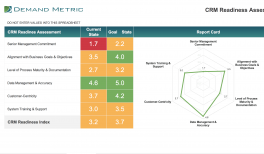In June 2013, Demand Metric conducted a study to assess sales and marketing alignment and how it impacts revenue performance.
Sales & Marketing Alignment Benchmark Report
Resource Overview
Related Resources
Executive Summary
How influential is sales and marketing alignment on achieving revenue goals? A Demand Metric Benchmark Study concluded that sales and marketing alignment is more than just “happy talk”; it has a real effect on revenue performance.
In June 2013, Demand Metric conducted a benchmarking study to assess the influences on sales and marketing alignment and how in turn it impacts revenue performance. Key findings from this study include:
- Not an “all or nothing” proposition: complete alignment of sales and marketing goals is related to the highest revenue achievement, but even partial alignment is far superior to none.
- Rose-colored glasses: Presidents, CEOs or owners of their firms are more likely to perceive strong or complete sales and marketing alignment than their sales and marketing teams.
- Two is better than one: Organizational structure is related to achievement. Separate sales and marketing teams outperform organizations where sales and marketing operate as a single, combined team.
- The one with the best tools wins: Mature implementations of sales and marketing systems, such as marketing automation or CRM, are having a significant impact on revenue achievement.
- Integration = Revenue: The highest level of revenue achievement coincides with the highest level of integration effectiveness between sales and marketing systems.
- Diminishing returns: once qualified leads account for 10% of total leads generated, revenue achievement remains flat even as the percentage of qualified leads increases.
Learn more about the impact of sales and marketing alignment on revenue performance by downloading a copy of the report.
Table of Contents
- Introduction
- Executive Summary
- Research Methodology
- Revenue Goal Acheivement
- Perception of Alignment
- Organizational Structure
- Alignment & Technology
- Leads & Lead Quality
- Analyst Bottom Line
- Acknowledgements
- About Demand Metric
Research Methodology
The Demand Metric 2013 Sales & Marketing Alignment Survey was administered online over a period of June 24th through June 30th, 2013. During that time, over 600 responses were collected, 550 of which were complete.
All members of the Demand Metric community received email invitations to participate in the survey, and participation was encouraged through a random draw incentive for an iPad Mini.
While respondent email addresses were collected in order to facilitate the prize drawing, no identifying information was retained or considered in the analysis of the survey data.
Following collection of the survey data, Demand Metric used IBM SPSS statistics software to analyze the results and draw statistically significant conclusions.





